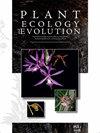短肢动物的核糖体系统发育:对雨林和Miombo林地进化的新认识的新标记
IF 1.1
4区 生物学
Q3 PLANT SCIENCES
引用次数: 1
摘要
背景和目的-Brachystegia是一个在热带非洲发现的物种丰富的乔木属,也是Miombo林地的典型元素,Miombo woodlands是赞比西大草原的一个广泛分布的亚型。质体DNA在评估物种系统发育关系方面基本上没有信息,因为叶绿体在物种之间广泛捕获。在这里,我们的目的是评估核核糖体DNA(rDNA)澄清Brachystegia物种系统发育的能力,同时考虑个体内位点多态性(2ISPs),这通常存在于rDNA中,并可能提供系统发育信息。材料和方法——对47个样本进行基因组撇除测序,这些样本代表了目前公认的29种Brachystegia物种中的27种,使我们能够检索到编码18S、5.8S和25S rRNA基因(35S rDNA)的完整核核糖体顺反子。我们使用基于标准替代模型或集成2ISPs(RAxML-NG中的GENOTYPE实现)的最大似然方法重建了Brachystegia系统发育。我们还测试了划分数据的效果(一个是rDNA基因的划分,一个是ITS1+ITS2的划分)。我们还进行了网络推断(邻居网络分裂图),因为严格的分叉方法可能无法在浅系统发育深度正确建模拓扑不确定性。关键结果——2ISP意识和标准的系统发育重建在很大程度上是一致的。我们确定了几个得到充分支持的主要分支,澄清了物种关系,包括Miombo林地物种的两个分支。Miombo类群A包括具有卵球形至球形腋生休眠芽的物种,而Miombo Group B物种具有扁平的休眠芽。在几内亚-刚果雨林中发现的两个形态相近的Brachystegia物种(B.kenedyi和B.leonensis)也形成了一个强大的分支。2ISP编码允许识别另一个几内亚-刚果分支(B.eurycoma和B.nigerica)。因此,核糖体DNA被证明比质体DNA更有助于探索一般的系统发育,但主要分支内部和之间的物种关系仍然很难解决,这可能是由于最近的多样化和/或反复杂交,因此Brachystegia的多样化仍有待更正确地表征。结论:Brachystegia物种的细胞核和质体系统发育重建不一致。即使没有很好地解决,rDNA系统图和网络也以分类排序为特征,而我们在质体数据集中观察到严格的地理排序。大多数物种的亲缘关系仍有待于使用额外的核标记和深入的形态学研究来表征。本文章由计算机程序翻译,如有差异,请以英文原文为准。
Nuclear ribosomal phylogeny of Brachystegia: new markers for new insights about rain forests and Miombo woodlands evolution
Background and aims – Brachystegia is a species-rich tree genus found in tropical Africa and a typical element of Miombo woodlands, a widely distributed subtype of the Zambezian savanna. Plastid DNA was shown to be largely uninformative to assess species phylogenetic relationships due to widespread chloroplast capture among species. Here, we aim to assess the capacity of nuclear ribosomal DNA (rDNA) to clarify the phylogeny of Brachystegia species while accounting for intra-individual site polymorphisms (2ISPs), which are often present in rDNA and potentially phylogenetically informative.
Material and methods – Genome skimming sequencing on 47 samples representing 27 of the 29 currently recognized Brachystegia species, allowed us to retrieve complete nuclear ribosomal cistrons encoding for 18S, 5.8S, and 25S rRNA genes (35S rDNA). We reconstructed the Brachystegia phylogeny using Maximum Likelihood methods based on the standard substitution model or integrating 2ISPs (GENOTYPE implementation in RAxML-NG). We additionally tested the effect of partitioning the data (one partition for rDNA genes and one for the ITS1+ITS2). We also conducted network inferences (Neighbor-Net splits graph), as a strict bifurcative approach might not properly model topological uncertainty at shallow phylogenetic depth.
Key results – 2ISPs-aware and standard phylogenetic reconstructions are largely congruent. We identified several well-supported main clades clarifying the species relationships, including two clades of Miombo woodlands species. Miombo Group A includes species with ovoid to globose axillary dormant buds, while Miombo Group B species have flattened ones. Two morphologically close Brachystegia species (B. kennedyi and B. leonensis) found in Guineo-Congolian rain forests form also a robustly supported clade. 2ISPs coding allowed to identify an additional Guineo-Congolian clade (B. eurycoma and B. nigerica). Ribosomal DNA therefore proves more useful to explore the generic phylogeny than plastid DNA but the species relationships within and among the main clades remain poorly resolved, probably due to recent diversification and/or recurrent hybridization, so that the diversification of Brachystegia remains to be more properly characterised.
Conclusion – Nuclear and plastid phylogenetic reconstructions of Brachystegia species are discordant. Even if not well-resolved, rDNA phylograms and networks are characterized by taxonomic sorting, while we observe a strictly geographic sorting in the plastid dataset. Most of the species’ relationships remain to be characterized using additional nuclear markers combined with in-depth morphological investigations.
求助全文
通过发布文献求助,成功后即可免费获取论文全文。
去求助
来源期刊

Plant Ecology and Evolution
PLANT SCIENCES-
CiteScore
2.20
自引率
9.10%
发文量
27
审稿时长
>12 weeks
期刊介绍:
Plant Ecology and Evolution is an international peer-reviewed journal devoted to ecology, phylogenetics and systematics of all ‘plant’ groups in the traditional sense (including algae, cyanobacteria, fungi, myxomycetes), also covering related fields.
The journal is published by Meise Botanic Garden and the Royal Botanical Society of Belgium.
 求助内容:
求助内容: 应助结果提醒方式:
应助结果提醒方式:


